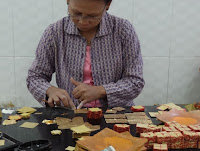 |
| Reclining Buddha |
Really don't like staying
up all night any more. The flight was only five hours but I never seem to be
able to sleep...so now it's 6 am, 3 Doha time, and we're still up. Good thing
we have a full day tour to keep us busy and walking around. Will sleep well
tonight!
The Buddhist temples here are plentiful and ornately decorated. Sadly the names are not frequently recorded in script we can read....some I did get, others...well, I will make a stab at their names. The first temple was one of a reclining Buddha, I believe called the Chaukhtatgyi Buddha.To my untutored eye, it looked as though he was carved out of a pure white rock like maybe alabaster, marble, or some other stone. The face had a beautiful smooth surface that was actually achieved through the use of bricks and concrete! The robe was spectacularly decorated with gold leaf, mirrors, and precious stones of various sorts.
The Buddhist temples here are plentiful and ornately decorated. Sadly the names are not frequently recorded in script we can read....some I did get, others...well, I will make a stab at their names. The first temple was one of a reclining Buddha, I believe called the Chaukhtatgyi Buddha.To my untutored eye, it looked as though he was carved out of a pure white rock like maybe alabaster, marble, or some other stone. The face had a beautiful smooth surface that was actually achieved through the use of bricks and concrete! The robe was spectacularly decorated with gold leaf, mirrors, and precious stones of various sorts.
 |
| The foot of Buddha |
Elsewhere around the temple there were other
Buddhas of varying ages. There are also eight Buddha figures that are representative
of the 8 planets and have been tied to the days of the week. Each day of the
week is further associated with a particular animal, for example Monday is a
tiger and Tuesday a lion. People would go to the day of the week they were born
on and wash the Buddha figure with the water that is provided for that purpose.
It appears that they will also go to the “unlucky” days to forestall bad luck –
apparently the water dragon on Saturday is an ill-omened character and thus
quite (un)popular.
 |
| Hair relic can be found here |
We headed off for Botataung Paya, an octagonal
golden stupa that has one of the hair relics from the Buddha. The story is that
at one time some Burmese merchants came upon the Buddha meditating and they
offered him some rice. In exchange they were given eight hairs from his head.
They have been enshrined across the country and are the sites for many to go to
pray. This particular stupa has eight spokes that you walk through to go all
the way around it. They have numerous statues of the Buddha from throughout the
ages, many thousands of years old. The walls are ornately decorated with
medallions, all covered in gold leaf. While most of the people seemed to have
come just for the hair relic, we took the opportunity to walk around with our
guide, Thouzah, to see all of it. From there it was a short trip to the lake
with a spectacular views of stupas and a dragon boat converted into a rather
expensive restaurant.
 |
| Clock Tower |
Burma /Mynmar was long a colony of England,
winning their freedom in about 1947. While the British may be gone, they left
behind hundreds of buildings throughout the country. Walking through the
downtown section, you could see the influence on almost every corner.
Interestingly, a few buildings were reminiscent of others we had seen in other
ex-British colonies...one in particular was a building very similar to Raffles
in Singapore. Clock towers seemed to also be popular. One of the historic hotel we roamed through was the
Sands Hotel. The wood faced walls and old fans lazily rotating from the ceiling
are also reminiscent of the hotels in Singapore...why change a good floor plan?


















































